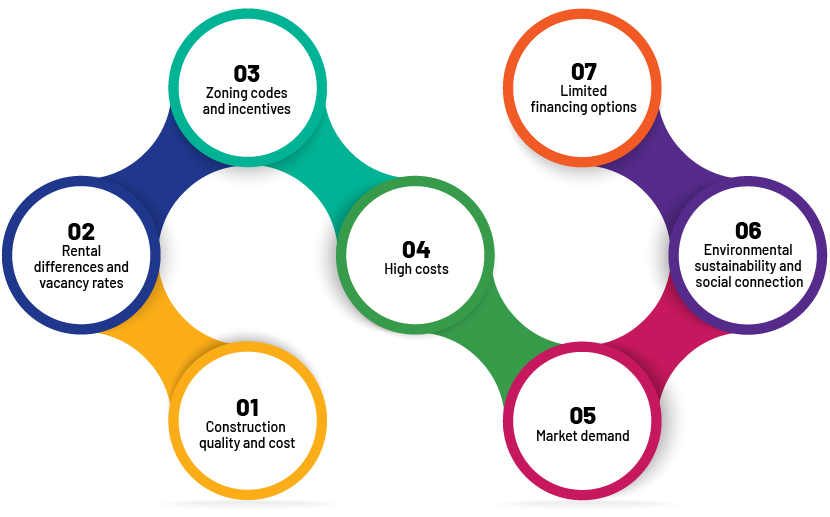Published on May 25, 2023 by Sumanth Mandava
Converting office space into multifamily residences is a change that could benefit both developers and residents. Office buildings that are outdated, vacant or located in areas with high residential demand could be transformed into modern and attractive apartments with many amenities and functions. The pandemic changed the way we work and live, affecting the real estate sector. As more employees work remotely or adopt hybrid models, the demand for office spaces decreases, resulting in higher vacancy and lower turnover.
As the pandemic and the shift to remote work reduce the demand for office spaces, the global rate of speculative-grade investment in office buildings rose from 2.6% in November 2021 to 2.8% in December 2021 and is projected to reach 5.1% by the end of 2023. At the same time, office property valuations in some markets fell to 45% from 28% due to declines in rents, occupancy and rentals. Tighter financial conditions also make it harder for investors to find financing or reinvest in office space. These conditions may cause some investors to move to multifamily or other desirable and profitable properties.
Office-to-multifamily (OTM) conversions are not a new phenomenon but have gained more attention and popularity in recent years. Conversion to multifamily has been the best practice for old office buildings. OTM mutations have accounted for about 1% of multifamily developments in the past 20 years and increased slightly since the start of the pandemic. More than 12m square feet of office space was converted to other uses in 2022 vs more than 8m square feet in 2021. This is expected to jump to almost 20m square feet in 2023.
7 Advantages of converting office to multi-family for CRE Investors
-
Demand and occupancy: Multifamily is one of the strongest and most attractive property types in the real estate market. The pandemic could not stop the booming demand for multifamily rental properties, which soared in 2021 and 2022, thanks to the positive behaviour of the citizens, the resilient job market, the growing income levels and the attractive rental rates. In addition, the lack of housing in the US, especially when combined with a shortage of affordable housing, high mortgage rates and financial stress, has made it difficult for many buyers to become homeowners, causing them to stay in rented houses for longer.
According to RealPage, the demand for multifamily housing is expected to fall short of new supply by 80,049 units in 2023 and 189,234 units in 2024. This is after a strong demand of 673,478 units in 2021 and a projected demand of 233,305 units in 2022. Despite this slowdown, many families are living well, with a national average of almost 95% occupancy in 2021 and 2022, because of this high demand. Strong demand for multifamily housing and high occupancy rates have translated into growth for rentals. CoStar expects rentals to grow 4.5% in 2023 and 3% in 2024.
-
Advantages of location: Most office buildings are in central business districts or cities with access to facilities such as public transport, shopping, dining and entertainment. This may appeal to residents who want to be close to their workplace or prefer an urban lifestyle. Multifamily buildings could help strengthen communities by bringing in more residents, jobs and diversity.
-
Environmental sustainability: Multifamily dwellings are a smart and eco-friendly choice, as they reuse existing buildings and materials instead of wasting them. This conserves energy, water and natural resources and prevents carbon emissions and construction waste. It would also promote green living by using energy-saving devices such as solar panels, LED lighting and thermostat quality, and using fewer vehicles by providing bicycle storage, electric car parking and recycling facilities.
-
Higher earning potential: Families could generate more rental income from office space, especially if it is old or unavailable. Office-to-residence conversion could increase income from 40% to 60%, according to a report by the Urban Land Institute. Additionally, multifamily properties tend to have lower prices and more stable income than office properties that are more responsive to businesses and tenants.
-
Value appreciation: Multifamily properties gain in value over time due to factors such as increased demand, limited supply, inflation and rising rents. On the other hand, the value of an office building may decrease due to uncertainty, competition and changes in tenant preferences. Investors could improve their assets and increase equity by converting office space into a multifamily residence.
-
Tax benefits: Multifamily business owners could benefit from a number of tax breaks and incentives, including deductions, interest rates, property taxes, maintenance fees and investment development. Investors could also use the 1031 exchange tax break to hedge their capital gains from taxes when they sell office property and purchase an equal or greater amount of real estate.
-
Community connections: Changing the workplace to a multifamily residence could strengthen a community by offering more housing options to diverse populations such as professional youth, families, seniors and low-income families. This would promote social inclusion, diversity and integration, and encourage local businesses and services. Such conversion also has the potential to create relationships and collaboration among residents by creating community spaces such as lounges, gyms, gardens and offices.
While OTM conversion may be a good idea for renovating deteriorated office buildings and creating new residences, it also entails many challenges and limitations.

7 Challenges and constraints – Things to consider
-
Construction quality and cost: Such conversion requires significant changes such as installing windows, balconies, kitchens, bathrooms, elevators, HVAC systems, fire safety measures and other facilities. These changes can be costly and time-consuming, depending on the age, size and configuration of the building.
-
Rental differences and vacancy rates: OTM conversion also depends on the difference between office and multifamily rents and occupancy rates in each market. In some markets such as San Francisco, Los Angeles and Washington, DC, Class B office rents are still higher than Class A multifamily rents, making the transition a negative one. In other markets such as Chicago, New York and Boston, Class B units offer lower rents than Class A multifamily units, marking a difference. However, even in these markets, the difference in rents may not be enough to offset the high construction costs and risks associated with OTM transfers.
-
Zoning codes and incentives: Other factors affecting the feasibility of an OTM conversion are local zoning laws and incentives that govern infrastructure development. Some cities have strict zoning laws that limit the density, height and use of buildings in certain areas; these could make renovation difficult or impossible without permits or changes to zoning laws. Other cities have more flexible zoning laws or incentives for redevelopment that preserves historic buildings or creates affordable housing. These incentives may include tax credits, speed bonuses, fast licensing or discounts.
-
High costs: Converting office space into multifamily residences requires significant investment in renovation, permitting, zoning, design and marketing. Depending on the office's condition and location, renovation costs could range from USD100 to USD300 per square foot. Investors should, therefore, complete market research and analysis before deciding to convert office spaces into multifamily residences, and office investors interested in OTM transactions should carefully weigh the pros and cons and seek professional advice.
-
Market demand: The demand for multifamily housing varies by location, submarket and product type. In some markets, there may not be enough demand for multifamily housing to justify the conversion of office buildings. This could be due to low population growth, high homeownership rates, abundant supply of existing or new multifamily units, or lack of amenities or transit access that attract renters. Conversions need to match the preferences and affordability of the target tenants and compete with other existing or new supply.
-
Environmental sustainability and social connection: Some multifamily tenants may not be satisfied with the environmental and social aspects of some office buildings. For example, some office buildings may use more energy, have worse air quality, generate more waste or have fewer green spaces than multifamily tenants want. Some office buildings may also not have a strong community or identity that multifamily tenants appreciate.
-
Limited financing options: Financing options for office to multifamily conversions may be limited or more expensive than for other types of projects. Lenders may perceive conversions as risky or speculative, requiring higher interest rates, lower loan-to-value ratios or more equity from borrowers. Alternatively, lenders may prefer to finance other uses of office buildings that have higher returns or lower costs than multifamily housing.

Conclusion
OTM exchanges are not a one-size-fits-all solution for real estate investors, but they can be a viable option for those looking for new ideas in an ever-changing business and could create value for developers and society. Despite the challenges and limitations, OTM conversion will likely remain a good idea for office investors who have buildings tailored for use by a specific sector.
However, the potential for OTM transactions is not being exploited in some markets because they already have a large number of small, old and multifamily homes. These markets include Denver, Seattle, Portland and Phoenix. Real estate investors who own homes in these markets may want to consider OTM transactions to expand their portfolios and capitalise on increased real estate demand.
How Acuity Knowledge Partners can help
The commercial real estate (CRE) sector is one of our key focus areas, and we have a large team of CRE analysts and subject-matter experts who support global financial institutions, brokers, investment firms and other service providers. We provide support across the CRE deal lifecycle – from loan origination, lease analysis, loan underwriting and valuation, guarantor analysis, covenant monitoring and testing, post-closing and portfolio monitoring to asset management. For more details, please refer to https://www.acuitykp.com/solutions/commercial-real-estate/
References:
-
Making the Math Work: Office-to-Multifamily Conversions: https://www.greystone.com/insights/making-the-math-work-office-to-multifamily-conversions/.
-
Speculative-Grade Bonds (Junk Bonds) https://moneyzine.com/investments/speculative-grade-bonds/
-
How to Make Office-to-Residential Conversions Work: https://urbanland.uli.org/planning-design/how-to-make-office-to-residential-conversions-work/.
-
Default Trends and Rating Transitions | Moody's: https://www.moodys.com/creditfoundations/Default-Trends-and-Rating-Transitions-05E002.
What's your view?
About the Author
Sumanth is an associate in the Lending Services team and has over four years of total experience in the commercial real estate sector. His expertise spans a broad range of analyses, including CRE loan underwriting, loan servicing, due diligence, portfolio monitoring, market research reports, and cash flow modelling. He currently supports in monitoring the CRE portfolio of one of the leading global insurance organization. He is an MBA (Finance) and has a Bachelor’s degree in Commerce.
Like the way we think?
Next time we post something new, we'll send it to your inbox






